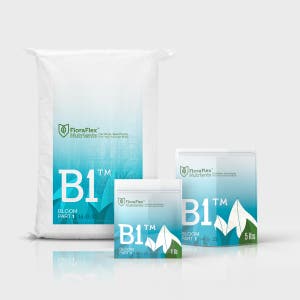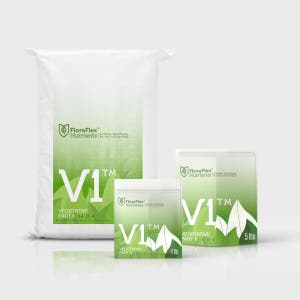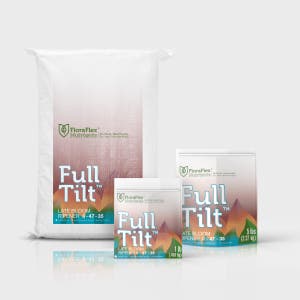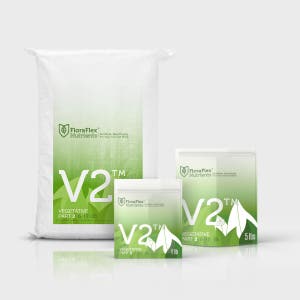Salt buildup is one of the most common challenges for growers using coco coir or rockwool, especially when fine-tuning irrigation strategies and pushing drybacks. When salts accumulate in your medium, they can cause extreme EC spikes, disrupt pH levels, and result in nutrient lockout.
In this guide, we’ll dive into how salt buildup occurs, compare how coco and rockwool handle drybacks, explore precise detection methods like the Dutch slurry test and syringe water extraction, and share irrigation strategies to prevent salt pockets. Learn how FloraFlex’s pH-stable nutrients and balanced feeding protocols help you prevent and manage salt buildup effectively.
What Causes Salt Buildup in Coco and Rockwool?
Salt buildup occurs when water evaporates faster than salts, causing them to concentrate within the growing medium. This happens due to:
- Pushing Drybacks Too Far: Allowing the medium to dry too much concentrates salts in the root zone.
- EC Levels Too High: Overfeeding plants increases the residual salts left behind.
- Channeling: Uneven irrigation leaves dry spots where salts accumulate.
- pH Instability: Fluctuating pH disrupts nutrient uptake, leaving unused salts behind.
"Are your plants showing signs of stress after drybacks? Pushing too far can spike EC and disrupt pH. Learn how coco and rockwool respond differently, how to detect salt buildup, and how FloraFlex pH-stable nutrients keep your root zone clean and balanced."
Coco vs. Rockwool: How Drybacks Impact Salt Buildup
Coco Coir: More Forgiving but Not Invincible
Coco coir buffers salts better than rockwool, making it more forgiving for growers. However, pushing drybacks beyond ideal levels causes rapid EC spikes, reducing nutrient availability.
- Ideal Dryback Range: 30-40% moisture loss from full saturation.
- When Problems Begin: Beyond 40% dryback, EC spikes sharply, and salt buildup stresses the root zone.
Detection Tip: Use the Dutch Slurry Test:
- Fully saturate coco with a 1/2 strength nutrient solution.
- Wait 20 minutes for the salts to stabilize.
- Mix 1 part coco with 1.5 parts distilled water and test the EC and pH of the slurry.
- Monitor the pH: If runoff pH rises more than 0.3 above input, increase feed strength or shorten drybacks. If it drops more than 0.3 below input, reduce feed strength or extend drybacks.
Rockwool: Highly Precise but Less Forgiving
Rockwool lacks coco’s buffering capacity, meaning it dries out faster and concentrates salts quickly. This makes it excellent for precise irrigation but less forgiving when drybacks are pushed too far.
- Ideal Dryback Range: 25-35% moisture loss from full saturation.
- When Problems Begin: Beyond 35% dryback, salts crystallize in dry zones, forming salt pockets that can lead to nutrient lockout.
Detection Tip: Use the Syringe Extraction Method:
- Fully saturate the rockwool block with a 1/2 strength nutrient solution.
- Wait 5-10 minutes for the salts to stabilize.
- Extract water from the center of the block using a syringe and measure EC and pH.
- Monitor the pH: If the pH increases or decreases more than 0.3 from the input pH, adjust feed strength or dryback times accordingly.
How to Flush Salt Buildup in Coco or Rockwool
Flushing the medium doesn’t mean using plain water; instead, a 1/2 strength feed prevents shock while restoring balance. Follow these steps:
1. Prepare a 1/2 Strength Nutrient Solution
- Use FloraFlex pH-stable nutrients to maintain consistency. Target a slightly lower EC than your standard feed.
2. Saturate the Medium
- Apply 2-3 times the volume of the growing medium to flush out excess salts.
- Ensure even watering to avoid channeling.
3. Monitor Runoff pH (Not EC)
- If Runoff pH Rises >0.3: This indicates low feed strength or overly aggressive drybacks. Increase feed strength or shorten drybacks.
- If Runoff pH Drops >0.3: This indicates overfeeding or insufficient drybacks. Decrease feed strength or extend drybacks.
This approach resets the medium while keeping nutrient availability stable, preventing plant shock from plain water flushes.
"Coco can tolerate 40% drybacks, but rockwool starts struggling beyond 35%. Keep your moisture levels in check!"
Irrigation Strategies to Prevent Salt Buildup
Proper irrigation practices are essential to prevent dry spots, channeling, and salt accumulation:
- Monitor and Manage Drybacks:
- Coco: Keep drybacks within 30-40% to avoid significant EC spikes.
- Rockwool: Stay within 25-35% to prevent salt crystallization and root stress.
- Use Low-Flow Drip Emitters:
- Ensure water spreads evenly to eliminate channeling and dry pockets.
- Multiple, Smaller Irrigations:
- Frequent short irrigations maintain even moisture and prevent excessive drying.
- Monitor Runoff EC and pH:
- Check multiple runoff zones to identify inconsistencies and adjust irrigation as needed.
Why FloraFlex Nutrients Reduce Salt Buildup
FloraFlex’s pH-stable, clean nutrients are designed to minimize salt buildup and lockout:
- pH Stability: Maintains a consistent pH range in the root zone, reducing imbalances that contribute to salt accumulation.
- High Solubility: Dissolves completely, preventing residue and salt pockets.
- Balanced Nutrients: Prevents overfeeding, ensuring plants use nutrients efficiently without excess salts.
Customer Testimonials: Real Grower Results
- "FloraFlex Keeps My Coco Balanced!"
"I used to see huge EC spikes during drybacks. Switching to FloraFlex and proper flushing fixed everything!" – Jamie L., Indoor Grower - "Rockwool Made Simple!"
"Syringe testing showed where I was pushing too hard. FloraFlex nutrients and smaller irrigations brought EC back under control." – Sarah P., Greenhouse Grower - "pH Stability Made the Difference!"
"Monitoring runoff pH with FloraFlex helped me fine-tune my feed strength and irrigation. No more salt buildup!" – Marco G., Commercial Grower






















